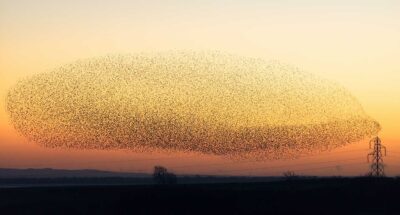
Finding Awe in Collective Acts of Kindness
Students watch an awe-inspiring video of animals moving together in unison, reflect on their experience of collective effervescence, and plan and carry out a collective act of kindness.

Students watch an awe-inspiring video of animals moving together in unison, reflect on their experience of collective effervescence, and plan and carry out a collective act of kindness.
Students will:
Studies suggest that humans are wired to move in unison with others—what some scientists call “collective effervescence.” For instance, researchers have found that 4-month-olds have a tendency to mirror adult facial gestures, and older children have a tendency to mirror the postures and gestures of teachers, parents, athletes, and musical artists. We feel awe in the extraordinary sensations of connecting to others in this way. Dancing with others, singing in a choir, or even just walking in sync with someone makes us aware of a “special something” that unites us in that movement. Moving in unison can also help people work together more effectively and increase people’s sense of compassion and cooperation.
Dacher Keltner, Ph.D, University of California Berkeley
Paul K. Piff, PhD, University of California, Irvine, and colleagues
Watching animals has been found to elicit feelings of awe and connectedness. In a study of more than 400 adult visitors to the Dalton Highway in northern Alaska, half of the special experiences that participants described involved being near animals, watching natural behavior, or seeing young animals, which in turn induced feelings of awe. In addition, a study that gathered narrative stories of five women and one man revealed how their encounters with whales and dolphins invoked peak experiences that involved feelings of connectedness and harmony.
Finally, a study of a diverse group of more than 2,000 college students and adults based in the United States, found that the experience of awe led to a diminished sense of self and personal concerns, as well as increased prosocial behavior. Researchers in the study highlighted that this can in turn help people feel a sense of belonging to a wider community, as well as enhance caring for others beyond themselves.
Awe helps build kinder classrooms and schools. In a world mostly guided by materialism and individual concerns, students are bombarded with values that put “me” first and “others” second. Awe has the power to shift these values, making students less entitled and more oriented towards helping others.
Indeed, by fostering a sense of connection between students, awe creates classrooms of belonging and inclusivity. Even a brief moment of awe encourages children to share more and act altruistically towards others. Awe also fosters students’ collective concern towards our larger society by inspiring them to tackle big issues like climate change, and by encouraging them to find common ground with people with whom they disagree.

Do you want to dive deeper into the science behind our GGIE practices? Enroll in one of our online courses for educators!
Comments